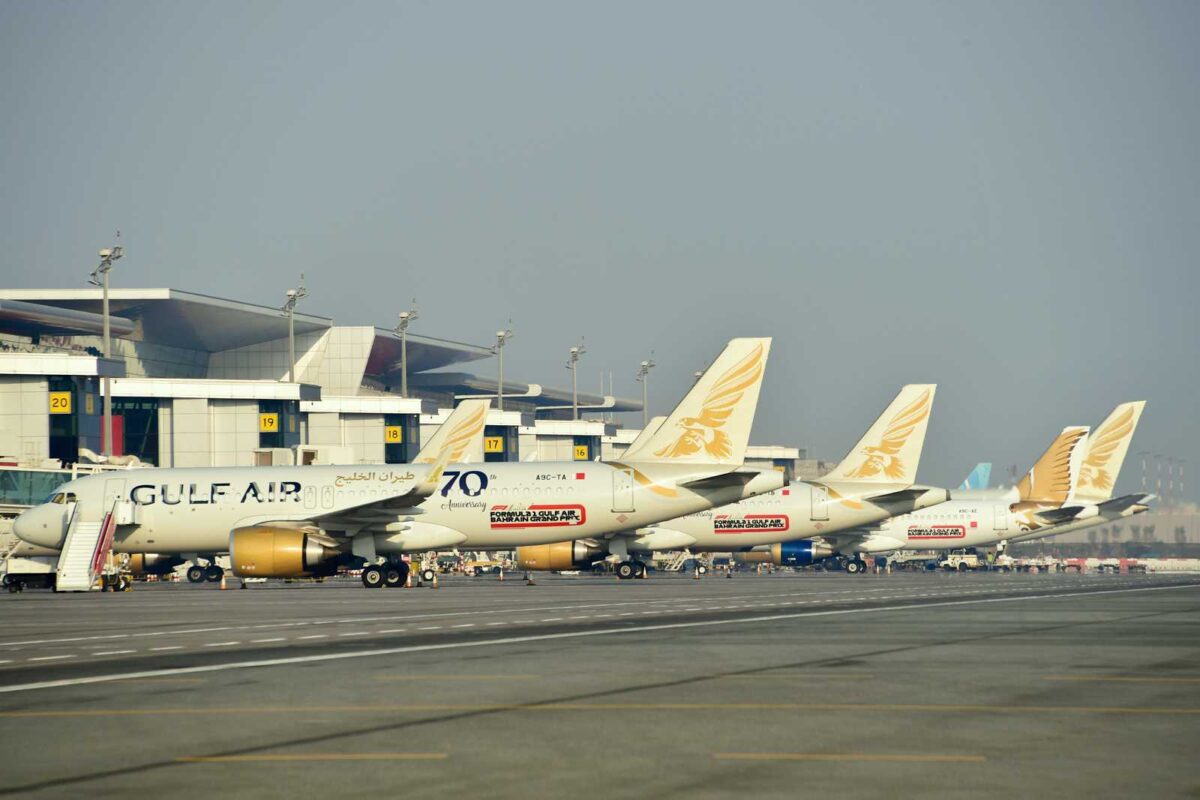The Gulf region has unquestionably become a key node in the global aviation industry. And amid the vigorous competition between fast expanding hubs and their corresponding airlines, one group has managed to stand out, not just because of its heritage as a pioneer of commercial aviation, but also because of its distinct integrated management approach.
Bahrain International Airport and its home airline, Gulf Air, have been connecting the world for nearly 75 years. Launched in 1950 as a joint project between several countries, Gulf Air came to be associated from early on with a level of excellence and service that has since been somewhat mirrored by younger airlines that have emerged in the region
As each of the original partners later developed an interest in having its own national carrier, Gulf Air strengthened its connection with the Kingdom of Bahrain, becoming its sole flag carrier and an essential component of its portfolio of aviation assets.

A vertically integrated aviation group
Because, rather uniquely in this industry, Bahrain’s commercial aviation sector is highly integrated, with the Gulf Air Group representing the national aviation assets of the Kingdom of Bahrain, the group has total and partial ownership of companies across the value chain. This includes Gulf Air, as the national airline, as well as the Bahrain Airport Company, which manages the Kingdom’s international air gateway, the Gulf Aviation Academy, Bahrain’s flight training school, which trains future pilots, tour operator Gulf Air Holidays, and several joint ventures with external companies which run auxiliary businesses.
The most prominent of these is Bahrain Airport Services, which runs ground handling and airline catering, but the group also holds stakes in other businesses providing hospitality and airport food and retail services.
Overseeing this diverse collection of businesses is Jeffrey Goh. A lawyer by training, Goh has worked in the aviation industry for most of his career, first practicing aviation law before moving on to the International Air Transport Association (IATA) and then Star Alliance, where he spent 16 years, the last six of which were as the CEO of the major airline alliance.
“I was offered the chance to move to Bahrain and after learning of the project, I thought this is a train I wanted to catch,” Goh said, explaining his move from Star Alliance to his current role, which he took up in January 2023.
“Our vision is to be a leading international aviation group,” he continued. “What we do is geared towards two very clear missions: to be a net positive contributor to the GDP of Bahrain as well as increase the international brand equity of the Kingdom.”
To do so, the Gulf Air Group aims to increase the connectivity between Bahrain International Airport and key cities around the world and to drive up the number of visitors and volume of cargo. Moreover, the group also wants to grow internationally by exporting its know-how to other geographies as an integrated national aviation group.
So, how does the group plan to achieve these goals in the highly competitive commercial aviation market of the Middle East?
In this contest, Bahrain is counting on the charms of its newly inaugurated airport. Unlike other airport projects in the area, this state-of-the-art facility, which opened in 2021, was not designed to be gigantic, but with efficiency and easy connectivity in mind.
“You can get to your gate in about 10 minutes, provided the check-in process is straightforward, and, while our advertised connection time between flights is 60 minutes, most of the time you are able to do it in about half this time,” Goh said proudly.
In 2024, Bahrain International Airport (BAH) expects to recover its pre-COVID traffic numbers of around 10 million passengers per year, which will leave about 40% of capacity (it was designed to handle 14 million annual passengers) for further growth.
Goh highlighted how both the airport and airline strategies are aligned with the Kingdom’s long-term strategy, which is encapsulated in an initiative called “Vision 2030”. This plan aims to boost visitor numbers and make Bahrain a major international tourism and logistics hub.
“We see ourselves as an enabler of this national policy on tourism and economic development,” Goh said. “We now have the project to recalibrate Gulf Air’s network and connect [Bahrain] to key cities and key leisure markets around the globe and make sure the airline remains relevant.”
Goh also mentioned some of the new destinations Gulf Air announced in 2024, such as Shanghai (PVG), Munich (MUC), Guangzhou (CAN), as part of this rebalancing of the network which, he said, is necessary to achieve these goals.
Being under the same corporate umbrella, there is obviously a deep dependency and a symbiotic relationship between the airport and airline. However, Goh clarified that this is not an impediment for other airlines coming into the airport. This is encouraged since it is seen as positive for the Kingdom.
Goh pointed out how Bahrain Airport Company has a program that has been developed within the group to provide an attractive proposition for airlines to fly to Bahrain and bring extra connectivity. In 2024, for example, four operators launched services to Bahrain in 2023 and six more have followed suit so far in 2024.
Talking about Gulf Air’s positioning in the broader international market, Goh said: “From an airline perspective, with our recalibrated network and fleet plans we believe that the pie is large enough to have our slice.”
“We don’t need to be a 400 aircraft airline,” he added. “To the extent that we keep a 50-60 aircraft fleet and remain disciplined and focused on our unique proposition and customer service, Gulf Air will keep its relevance in the international market.”
He continued: “Even if there are more airlines flying to Bahrain as a result of Bahrain Airport Company’s framework to attract new carriers and connectivity, Gulf Air is up to face this additional competition, this will only make us stronger. But what it is important, for both Gulf Air and the BAC, is to look at it from the perspective of a national aviation asset. If there is a net positive for the Kingdom, then these activities are to be supported and developed.”
Building brand equity for its home country
Like most of its neighbors, Bahrain is investing in the development of its local tourism infrastructure. The goal is to entice more visitors to spend time in the country and contribute to the development of the local tourism sector.
Goh explained how, at the moment, transit passengers account for around 60% of traffic at Bahrain Airport, but he is confident that, with time, this number can be balanced with origin and destination (O&D) traffic.
“In the meantime, as we develop this tourism infrastructure, as we introduce Bahrain to the world, as we build the country’s brand equity, we are working together with Bahrain’s tourism authority to develop what I would call ‘interim propositions’ to attract more visitors,” he continued.
One of the projects is a stopover program called “Hello Bahrain”, launched in 2023 and spanning several phases.
The first of these phases is aimed at passengers with transfers of more than five hours. This service provides passengers with a glimpse of several of Bahrain’s most interesting sights between flights.
The group is now moving to implement phase two of the stopover program in cooperation with the Kingdom’s tourism authority. This new product will facilitate stays of one or two nights in Bahrain at advantageous rates, as part of the connecting experience.
The third phase will involve multi-city stopover packages, in which Gulf Air will facilitate travelers using their stopover to combine a visit to Bahrain with other cities in the region, such as Muscat or Riyadh, for example.
Goh explained that what has been implemented so far has received a warm reception.
“More than 90% of those [Hello Bahrain users] that completed the survey said they would come back as a result of this introduction to the country,” he said.
He also explained how the Gulf Air Group is planning to strengthen its cargo and logistics business. The airline does not have dedicated cargo aircraft but carries lots of cargo in the belly of its passenger aircraft.
Bahrain Airport has long been a major regional hub for the logistics firm DHL. This, Goh remarked, helps establish Bahrain’s credentials as a logistics hub. The Bahrain Airport Company plans to continue investing in the development of this sector, including the creation of a new area within the airport dedicated to logistics activities.
“The whole logistics development program is flexible and open, in this regard,” he added. “We can accommodate different types of goods and merchandise.”
Another important project that Gulf Air Group is working on involves the construction of a new facility for the maintenance, repair, and overhaul (MRO) of aircraft.
This MRO facility, which will occupy a sizable plot and is still in the planning stage, is viewed by Goh not only as a significant opportunity to establish a foothold in a globally growing market but also as a platform for the training and career development of many qualified local professionals.
Goh concluded by explaining how both the Bahrain Airport Company and Bahrain Airport Services are considering expanding abroad to provide services and expertise to other airports around the world. While Bahrain Airport plays a central role in the Kingdom’s project to build its international brand equity, some of the group’s next major projects may well take place overseas.

